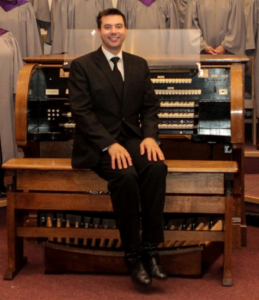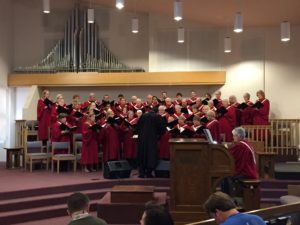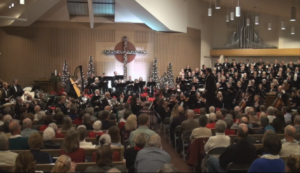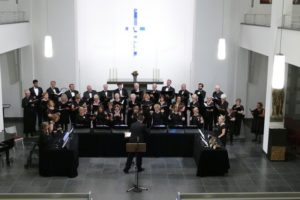By Dr. John Howard

Many people involved in traditional music ministry in churches these days find it a much more uphill struggle than it once was. The culture in America has changed and church attendance is the exception more than the rule. On top of that, a greater and ever-increasing divide exists between classical music (from which traditional church music stems) and popular music (in its seemingly limitless genres and sub genres). The church has been called to worship God above all things. One way to do that of course, is to reach the world that Christ died to save. We know that we have a timeless gospel message that can transform the world, and that will always be relevant, yet the church in our day in age struggles to communicate that message. “What should we do?” cry thousands of small to medium-sized churches who have shrunk and are aging rapidly. For several decades now, churches have been trying to solve a multi-faceted problem by turning to music in worship that is most often termed “contemporary.” The intention is good of course, because they are trying to reach the world. In my 20 years of experience and research in many denominations and churches, however, it doesn’t always achieve the desired results. Even in the places where it works very well, it doesn’t reach EVERYONE. My aim is not to criticize contemporary music but instead to show how traditional church music can be used as a very powerful tool to promote outreach and evangelism as well as worship.
I have recently passed my four-year anniversary at First Presbyterian Church in Grand Junction, CO. Grand Junction is a city in Western Colorado with a population of about 60,000. We are the largest city in our area between Denver to the East and Salt Lake City to the northwest. In this location, we have a couple of very large mega churches who produce sophisticated contemporary music. We also have many small churches, a very few of which still have small choirs and maybe an organ. In this setting, “First Pres” is a medium sized church. The senior pastor, Tom Hansen, came in 2005 and has worked for years to create a culture which is welcoming, outreach minded, and gospel centered, and from the time he came when the church had an average of about 250 weekly worshipers, to the time I came, in 2014, attendance had grown to around 450. The pastor and I have the same vision for outreach and a welcoming ministry to all, which is the first step to a growing church: HIRE PEOPLE WITH THE SAME VISION!

When I came, the music ministry was medium sized. 30 on the roster of the adult choir (which meant that our low attendance Sunday was 18 and a high Sunday was 26 or so). They mostly were grey haired and well-meaning folks, but many did not read music well. They had been singing lots of two- and three-part music before my arrival, though they had several tenors and several basses. The bell choir was good, though we needed a few more ringers to play our full five-octave set. The praise band for the separate contemporary worship service is led by a part time director. There was also a “simply traditional” service at 8am, with about 40 in attendance, that had congregational hymns sung with organ, a prelude and postlude, but no other music. It had to be kept short so the next service could be on time. Also noteworthy, the music department hadn’t given concerts for at least about 9 or 10 years before my arrival.
I came with the idea that the purpose of church music is to worship God but ALSO to reach the community. People who will not come to church for a service will often be very happy to come for a concert of music that is classical in nature, though sacred in its message. In this way, traditional church music performed with excellence is our bridge to the community. The church can be a center for people to come to be inspired and uplifted through music which will often touch the deep parts of the soul.
With this idea in mind, we started a Christmas choral concert. The first year was a simple service of lessons and carols with the choir, bells, a string quartet, and organ. We had a local public high school choir join us for a few pieces in the program. We also had a small group of kids sing a couple verses in the concert. This added variety, youth, and interest to the concert. We formed the “concert choir” in addition to our regular “worship choir” which allowed people who didn’t normally sing in the choir at the 11am service to join us for this one-time commitment. This is another key to growing a music ministry: CREATE FLEXIBLE OPTIONS FOR PARTICIPATION!
This brought our choir attendance up to about 35 for our first concert. This also included a college student from the church who was a music major at the local university. He needed an accompanist at school for voice lessons, so I traded free accompanying for his participation in the church choir. Suddenly our bass section was markedly better, and the choir took its first step to be intergenerational! It would start a ministry with the college music students where we would eventually have up to 12 college students in our choir at any one time! That’s another key: FIND CREATIVE WAYS TO GROW AN INTERGENERATIONAL MINISTRY! Older folks have a lot to instill in younger folks, and younger folks give fresh vitality and life to your choir and church. Also, young people who learn the benefits of traditional music ministry will be the torchbearers for the next generation.
The concert was a huge success, 500 people showed up. I attributed it to the fact that I was still in my “honeymoon period” and the choir was so excited that they invited everyone they knew! The sanctuary seats 300 really packed, and so we had about 200 in the lobby peering in the glass windows and doors!
The following Spring, we presented a Good Friday Choral Concert (Stainer’s Crucifixion) with a guest organist and soloists. The concert choir grew to about 40 by then, as the word spread. The choir was growing with both younger members and many non-churched singers. By the late spring concert where we performed Morning Has Broken by Diane Bish, and we had 50 in the concert choir with our first concert accompanied by an orchestra hired from the local symphony! We gave two performances to a packed church. We gave that performance on a Sunday morning instead of traditional and contemporary worship services, so everyone who came to church got to experience the power of these hymns presented with a large choir and good orchestra. People were really beginning to realize the impact of great traditional church music. Many non-church members were in attendance.
By the following Christmas, 2015, we decided to add a second performance of the concert, in case all 500 people returned! This time we did a concert called “Messiah and More” (favorite Christmas selections of Messiah interspersed with beautiful carol arrangements accompanied by an orchestra hired form the Grand Junction Symphony). We had the high school choir return and also a small community choral group I conducted on the side as well. This kept up the variety. When the performances came, we were stunned that 500 people came to each service! Once again, 200 were in the lobby BOTH TIMES! This is another key for growth: WHEN PEOPLE LOVE WHAT THEY ARE EXPERIENCING, THEY TELL OTHERS!
The third year we planned three performances. We tried to give out free tickets to control the crowd. They were gone in the first 20 minutes of the day we advertised that they were available. There was such demand that we added a fourth performance. All were full and the tickets only added anxiety to all concerned so we dropped that idea.
By last year, when we performed “The Many Moods of Christmas” by Shaw/Bennett, we had four performances again which were packed. With a safety team in place limiting the number of lobby seats for fire codes, we had to turn away about 500 people over the course of the weekend!

It isn’t just the concerts that have grown however. The concerts have helped many people to become familiar with our church. Many singers in our current worship choir (which now has grown to about 65) first came to our church at a concert. Several people in our church each week have had the same experience. They enjoyed the concerts so much that they decided to attend a service. When they did, they realized that there is also really inspiring choral and organ music there as well, and, thanks to the great gospel preaching and friendly warm culture that our pastor has worked so hard to develop, they have every reason to stay and belong to our church family. They come initially to be entertained or inspired and many find a place to belong.

Our 9:30 contemporary service is now held in a new wing of our building, so we moved our 8am simply traditional service to 8:30am, added a choir to it (choir members sign up to sing at both services periodically or as able), and made both traditional services identical with about 25 in the 8:30 choir for a congregation of about 100+, and 40 in the 11am choir for a congregation of about 225+. This has allowed some of those who used to attend the 11am service (to hear the choir) to now attend 8:30 am service and create more space for visitors at the 11am service. Each service has grown, the choirs have grown, the bell choir continues to thrive, and this year we added a men’s ensemble (12 men who sing four-part harmony) and a children’s choir (30-35 children have been showing up from the church and community because First Pres now has a name for great music and parents tell other non-churched parents). Things are going well in many ways and we are humbled and excited to see what God will do next!
If I was asked to give advice on how to make something similar happen in your situation, it would be hard to do, because each situation is different. There are a few things that I think are important in every situation, though.
1. Seek to give God the glory for every good thing that your ministry accomplishes. Pride or desire to promote one’s self can ruin great things.
2. Seek excellence in all things. Practice, learn, study, grow, and pursue your very best with all that you have. Don’t blame a lack of tenors or high sopranos for a lack of a great choir. Take responsibility for everything and find ways to help your people get better and to recruit new people who are just what you may need. Most importantly, while you pursue excellence, NEVER LET PERFECTIONISM CREEP IN! It is deadly and destructive and will hinder you in untold ways.
3. Care for people first. Music comes second. I love great music and I want to share it with others, but I must always select music that my choirs can be successful with and that they (and the congregation) will “GET” and find meaningful in worship or concert. Let your care for others extend in the way you treat people in rehearsals and in everyday situations. Go the extra mile to CARE and they will bend backwards to help you when you need it. Build real relationships.
4. Be passionate about the world outside of your church walls. Attend musical and cultural events, take side jobs in music to get to know the musical community, or volunteer as a musician in some capacity in your community. They will get to know you and the church you represent, and you will be a bridge builder to your church and to the timeless lifechanging gospel message.
5. Don’t worry about how much or how little you get paid to do your church work. Instead, do the very best you can and put in any time necessary to make your music ministry as excellent and effective as possible. Later, you may find when things grow and prosper, the church will decide you have earned a raise. If and when that doesn’t happen, DON’T STOP GIVING YOUR ALL. We serve our Lord, not our church board or pastor. We give all we have for Him and to impact our community for eternity. God will bless you for it even if your church won’t! If you are in it for the money or the musical experience alone, quit. “The chief end of man is to glorify God and enjoy Him forever.” This should be the chief end of church music as well.
6. Don’t expect immediate results. Like investing, patience is required. As is experimenting with different ideas. Changing jobs all the time because “the grass is always greener on the other side” will not work. You need to be established for a few years to begin to really develop a ministry. It takes many years to become a great organist or pianist, or singer, or conductor, so it takes many years to build a great choir and dynamic music ministry!
7. Don’t get competitive and upset by contemporary music. You may have strong feelings about it, but let them go. Focus your energy on being your best. Do what is in front of you and don’t worry about what others are up to or what people say that might try to discourage you in your efforts. Keep your eyes on the prize and press on for God’s glory.
A native of San Diego, Dr. John Howard graduated from Christian Heritage College, eventually earning an MA at San Diego State University, and the DMA from the University of Southern Mississippi. He has served churches in several denominations before arriving at First Presbyterian in Grand Junction, CO, where he is Director of Music and Worship Arts.